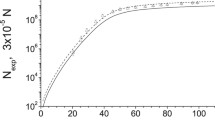Abstract
Generation of “twin beams” (of light with two-mode compression) in single-pass optical parametric amplifier (a crystal with a nonzero quadratic susceptibility) is considered. Radiation at the output of the nonlinear crystal is essentially multimode, which raises the question about the effect of the detection volume on the extent of suppression of noise from the difference photocurrent of the detectors. In addition, the longitudinal as well as transverse size of the region in which parametric transformation takes place is of fundamental importance. It is shown that maximal suppression of noise from difference photocurrent requires a high degree of entanglement of two-photon light at the outlet of the parametric amplifier, which is defined by Federov et al. [Phys. Rev. A 77, 032336 (2008)] as the ratio of the intensity distribution width to the correlation function width. The detection volume should be chosen taking into account both these quantities. Various modes of single-pass generation of twin beams (noncollinear frequency-degenerate and collinear frequency-nondegenerate synchronism of type I, as well as collinear frequency-degenerate synchronism of type II) are considered in connection with the degree of entanglement.
Similar content being viewed by others
References
O. Jedrkiewicz, Y.-K. Jiang, E. Brambilla, et al., Phys. Rev. Lett. 93, 243 601 (2004).
M. Bondani, A. Allevi, G. Zambra, et al., Phys. Rev. A: At., Mol., Opt. Phys. 76, 013 833 (2007).
M. V. Fedorov, M. A. Efremov, A. E. Kazakov, et al., Phys. Rev. A: At., Mol., Opt. Phys. 69, 052 117 (2004).
M. V. Fedorov, M. A. Efremov, A. E. Kazakov, et al., Phys. Rev. A: At., Mol., Opt. Phys. 72, 032 110 (2005).
C. K. Law, I. A. Walmsley, and J. H. Eberly, Phys. Rev. Lett. 84, 5304 (2000).
R. S. Bennink and R. W. Boyd, Phys. Rev. A: At., Mol., Opt. Phys. 66, 053815-1 (2002).
W. Wasilewski, A. I. Lvovsky, K. Banaszek, and C. Radzewicz, Phys. Rev. A: At., Mol., Opt. Phys. 73, 063819-1 (2006).
A. V. Burlakov, M. V. Chekhova, D. N. Klyshko, et al., Phys. Rev. A: At., Mol., Opt. Phys. 56, 3214 (1997).
C. H. Monken, P. H. Souto Ribeiro, and S. Pardua, Phys. Rev. A: At., Mol., Opt. Phys. 57, 3123 (1998).
M. V. Fedorov, M. A. Efremov, P. A. Volkov, et al., Phys. Rev. Lett. 99, 063901 (2007).
M. V. Fedorov, M. A. Efremov, P. A. Volkov, et al., Phys. Rev. A: At., Mol., Opt. Phys. 77, 032336 (2008).
M. Kolobov, Rev. Mod. Phys. 71, 1539 (1999).
E. Brambilla, A. Gatti, M. Bache, and L. A. Lugiato, Phys. Rev. A: At., Mol., Opt. Phys. 69, 023 802 (2004).
A. V. Belinsky and D. N. Klyshko, Laser Phys. 4, 663 (1994).
T. E. Keller and M. H. Rubin, Phys. Rev. A: At., Mol., Opt. Phys. 56, 1534 (1997).
W. P. Grice and I. A. Walmsley, Phys. Rev. A: At., Mol., Opt. Phys. 56, 1627 (1997).
Yu. M. Mikhailova, P. A. Volkov, and M. V. Fedorov, arXiv:0801.0689v1.
D. Strekalov, A. B. Matsko, A. A. Savchenkov, and L. Maleki, Phys. Rev. A: At., Mol., Opt. Phys. 71, 041803(R) (2005).
C. K. Law and J. H. Eberly, Phys. Rev. Lett. 92, 243601 (2004).
O. A. Ivanova, T. Sh. Iskhakov, A. N. Penin, and M. V. Chekhova, Kvantovaya Élektron. (Moscow) 36,951 (2006).
W. P. Grice, A. B. U’Ren, and I. A. Walmsley, Phys. Rev. A: At., Mol., Opt. Phys. 64, 063815 (2001).
V. P. Karasev and A. V. Masalov, Opt. Spektrosk. 74(5), 928 (1993) [Opt. Spectrosc. 74 (5), 551 (1993)].
Author information
Authors and Affiliations
Corresponding author
Additional information
Original Russian Text © G.O. Rytikov, M.V. Chekhova, 2008, published in Zhurnal Éksperimental’noĭ i Teoreticheskoĭ Fiziki, 2008, Vol. 134, No. 6, pp. 1082–1092.
Rights and permissions
About this article
Cite this article
Rytikov, G.O., Chekhova, M.V. Detection of two-mode compression and degree of entanglement in continuous variables in parametric scattering of light. J. Exp. Theor. Phys. 107, 923–932 (2008). https://doi.org/10.1134/S1063776108120029
Received:
Published:
Issue Date:
DOI: https://doi.org/10.1134/S1063776108120029



